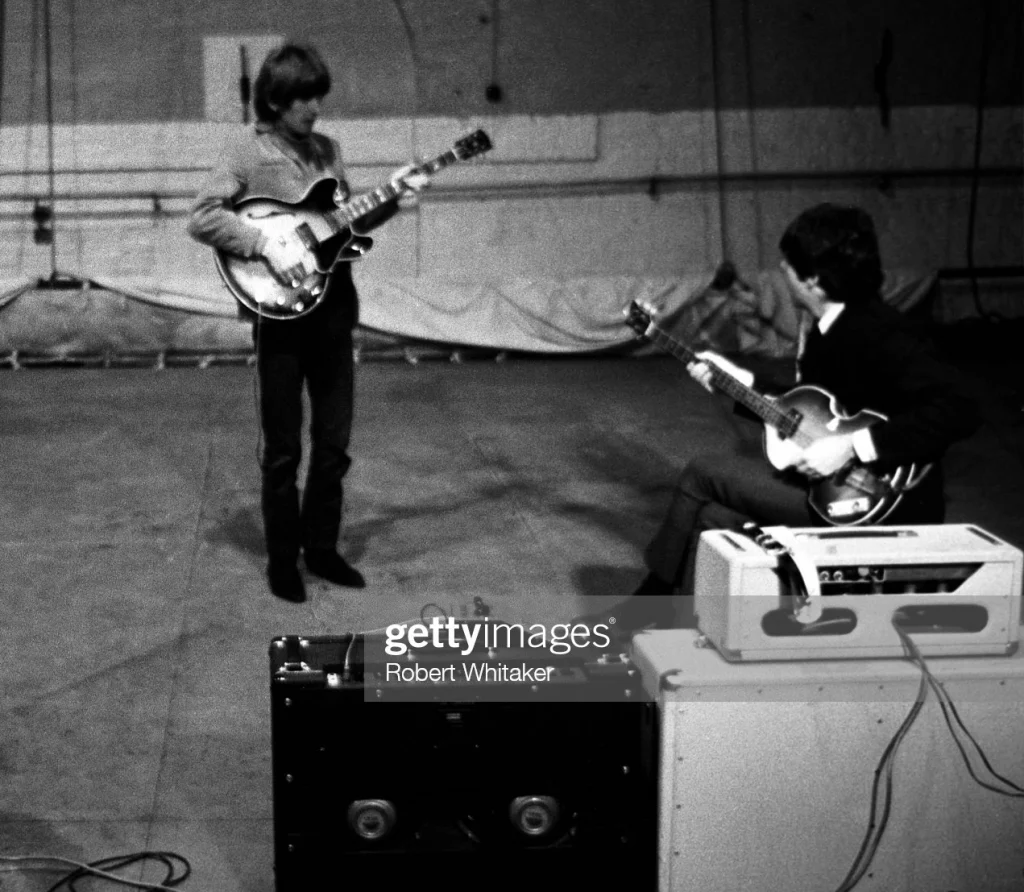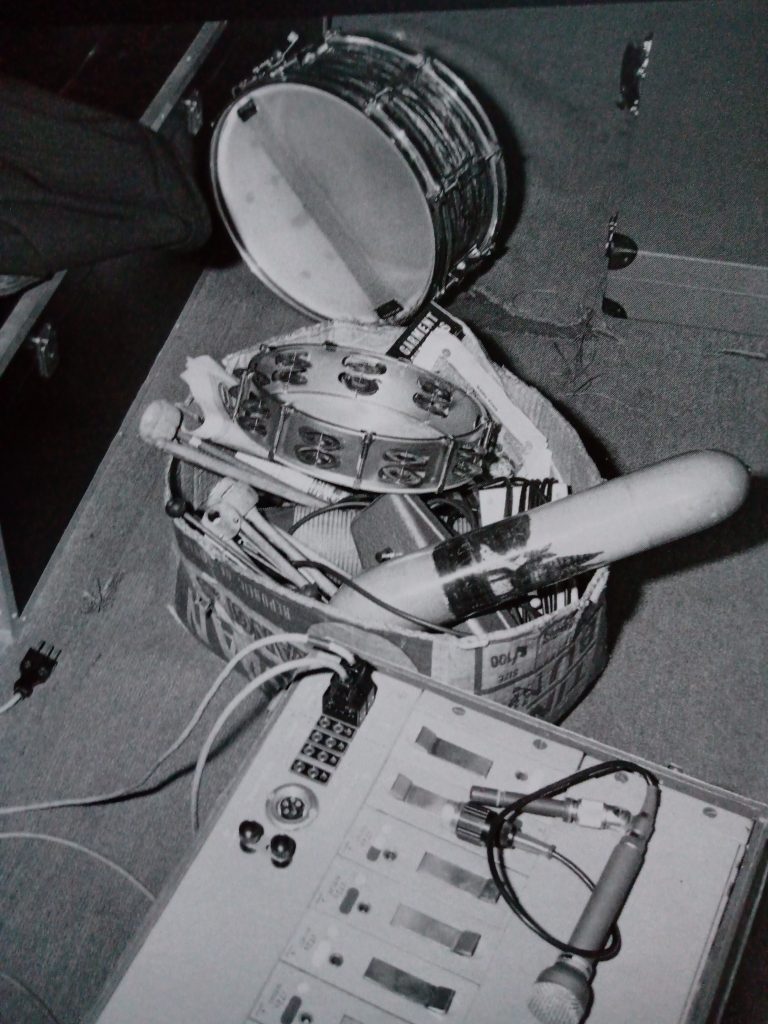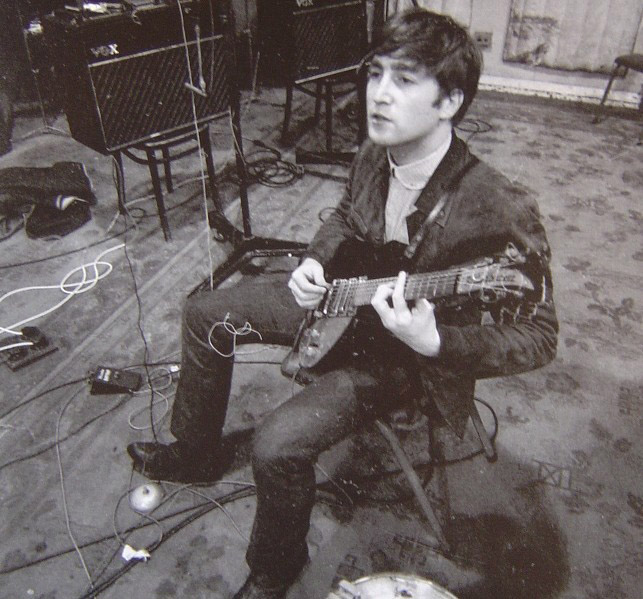Much has been written over the decades about the ways in which the Beatles experimented in the studio, and how the Fab Four developed new sounds and recording techniques. The group’s use of electric guitar & bass treatments, however, is still somewhat murky. Even though the day-to-day proceedings of studio sessions were documented extensively, all the information about specific models of guitar effects units has been gleaned from photo & video evidence, as well as from limited anecdotal testimony.
Effects units used by the Beatles include the early (Italian-built, pre-JEN) Dallas-Arbiter Wah Face (wah-wah), the Arbiter Add-a-Sound (octave divider), and the Arbiter Soundimension (echo unit). From 1965 right up until the group’s demise, the group also recorded distorted guitar tracks. Some of these tracks were reportedly distorted with overloaded recording consoles,1 and others may have been done with the built-in ‘fuzz’ effects on solid state Vox amplifiers used during the mid-to-late 1960s.
The Beatles also made use of numerous different fuzz boxes during their recording career, and that is where the focus of this article lies. Much of the source material here is in the form of period photography, and so a keen eye is often required to spot the low-resolution foot pedals. Photos of the Beatles have been supplemented with photos of similar pedals from my own collection, for reference purposes. Zooming in and/or adjusting screen brightness is strongly recommended!
1963



The Beatles are among the earliest professional musicians to have obtained a fuzz box in the UK. Anecdotal evidence reveals that the group acquired a (Gibson) Maestro Fuzz-Tone from the Selmer shop on Charing Cross Road,2 and were photographed using the model as early as in 1963.
The photos above show George Harrison on July 1st 1963, plugged into an early Maestro Fuzz-Tone, during the recording sessions for She loves you. The sounds of this unit were perhaps a little far ahead of its time, and apparently did not make it to the final cut of the song. (Photo credit unknown)
John Lennon was photographed only a few months later (below), on September 12th 1963, using what was possibly the same Maestro pedal, during the recording sessions for Don’t bother me. According to a Melody Maker journalist present during the recording, Lennon was pleased with the sound of the Fuzz-Tone, but following guidance from producer George Martin, again, the fuzz box failed to make the final cut.3 (Photo credit: Norman Parkinson)
1965
Following the releases of popular songs like the Rolling Stones’ (I can’t get no) Satisfaction and the Yardbirds’ Heart full of soul in 1965, the use of the fuzz box in the UK had finally started to gain traction. On November 8th 1965, the Beatles would record what would become one of the most well-known examples of a fuzz-bass track: Think for yourself. Exact details about the fuzz box that was used are unknown, but Ken Townsend (an EMI engineer) recalled the group using bespoke units that were built by technical staff at the studio.4 George Harrison also confirmed the use of a fuzz box on the recording,5 as opposed to something like an overdriven recording console.
Over the years it has also been rumoured that the Beatles may have used an early Tone Bender [‘MKI’] for Think for yourself, but there is no evidence known yet to confirm that. The rumour may have begun as a result of the Beatles having been documented acquiring Tone Benders very close to the time when the Rubber Soul LP was released.




Gary Hurst recalled, in a 2010 interview, having personally delivered two Tone Benders to the Beatles during a rehearsal.6 A set of photos taken on November 20th 1965 (some of which are pictured above) corroborate Hurst’s account of events. In them, Paul and George can each be seen at various times plugged into Tone Bender ‘MKI’ pedals. Hurst, himself, is also visible in one of the pictures from the set. (Photo credit: Robert Whitaker/Getty Images)
Because these photos from the Donmar Hall rehearsal are dated several weeks after the recording session for Think for yourself, we can safely rule out the possibility that either of the two Tone Benders pictured in them might have been used for Paul McCartney’s famous fuzz-bass track.
A further fuzz box that the Beatles may have experimented (or even recorded) with in 1965 is one that Dick Denney recalled, in an interview, supplying the group with at the time.7 Denney described the model in 1997 as a “prototype” for the Vox Tone Bender, but his use of the ‘Tone Bender’ name should not necessarily be seen as evidence that whatever model Denney built was related to the Gary Hurst & Sola Sound Tone Bender pedals. This is because the famous Tone Benders that Vox eventually did offer for sale were manufactured significantly later in the 1960s than when Denney reportedly made a prototype for the Beatles (and because the actual Tone Benders were built with numerous different circuits, by different companies between the UK & Italy, rather than by Denney).
1966
The Beatles continued experimenting with new technologies into the following year, and for the group’s follow-up to Rubber Soul, the 1966 Revolver LP featured numerous instances of fuzz guitar.
It isn’t known whether the fuzz sounds on Revolver were achieved with fuzz boxes, or perhaps whether they came as a result of overdriven amplifiers or recording consoles. Photographic evidence does reveal, however, that the Beatles were using at least two different fuzz boxes during the course of the Revolver sessions.




Photos taken around April 13th-14th 1966, at EMI Studios, depict the Beatles rehearsing & recording parts for Paperback writer & Rain. In them, John Lennon can be seen several times playing his Epiphone Casino with an early WEM Rush Pep Box.
In a more recent interview, Pepe Rush recalled that the Fab Four were supplied with Pep Boxes by Charlie Watkins.8 (Photo credits: Leslie Bryce & unknown)



A photo from a slightly later session (above), dated April 26th, shows a Tone Bender pedal sitting on top of an amplifier. Even though there isn’t very much detail in the photo, the place & timing of this session strongly suggests that it was a Tone Bender ‘MK1.5’. This is because Sola Sound’s Tone Bender MKII only began being advertised in the press in late 1966, and because the Italian-built Vox Tone Bender (model v828), which looks very similar to the Beatles’ pedal, was not being sold in England at the time. (Photo credit: Robert Freeman)
The Beatles apparently owned both the Tone Bender and the Pep Box at the same time. A recently-discovered photo of a basket of some of the Beatles’ equipment at EMI Studios shows both fuzz boxes stored together among the assorted percussion.
Later that year, an insurance statement (below) dated October 1966, listing the Beatles’ Vox equipment, included two Tone Bender pedals with a declared value of £14.14.0 each. This suggests a possibility that the group may have still owned the two Tone Bender ‘MKI’ fuzz boxes that they were photographed having acquired in the previous year (which had a retail price of £14). Whether that is the case, or whether this document refers to the later Tone Bender ‘MK1.5’, which was used during the Revolver sessions, (or perhaps even a brand new Tone Bender Professional MKII) is impossible to determine.
Interestingly, the Vox equipment insurance statement lists a nondescript wah-wah pedal, apparently several months before the model became widely available to the public. This reveals that the Beatles were also among the very earliest users of the wah-wah effect, although there is no known recording of the group using wah-wah until much later.
1969



There aren’t any other known images of the Beatles using fuzz boxes again until the group were filmed during the Get Back/Let it be sessions, in January 1969. The Fab Four had access to silver & red (Dallas) Arbiter Fuzz Face pedals at both the Twickenham Film Studios and at the new 3 Savile Row Apple headquarters locations. (Photo credit: Ethan Russell & Apple Films)
The Fuzz Face was introduced by Arbiter in 1966, and initially it featured a germanium transistor fuzz circuit. By the late 1960s, the Fuzz Face was redesigned to accommodate silicon transistors instead. Both versions of the Fuzz Face circuit have been sighted in red and in silver enclosures, and because of that it is impossible to determine whether the Beatles’ Fuzz Faces in 1969 had the germanium or the silicon-transistor circuits.
It’s unlikely that either of these pedals were actually used on any formal studio releases, but the Beatles can be briefly heard discussing and experimenting with the model during the Let it be sessions on an impromptu demo entitled ‘They call me fuzz face’ (which can be found on the ‘Nagra Reels’).
Thanks to Jon Charles
- Lewisohn, Mark, The Beatles Recording Sessions, Harmony Books, 1989, p. 142
- Babiuk, Andy, Beatles Gear: All the Fab Four’s Instruments from Stage to Studio (Revised edition), Backbeat Books, 2002, p. 92
- Babiuk, Andy, Beatles Gear: All the Fab Four’s Instruments from Stage to Studio (Revised edition), Backbeat Books, 2002, p. 96
- Lewisohn, Mark, The Beatles Recording Sessions, Harmony Books, 1989, p. 67
- The Beatles, The Beatles Anthology, Cassell, 2000, p. 196
- Shinko Music Mook, The Effector Book, vol. 7, 2010
- Babiuk, Andy, Beatles Gear: All the Fab Four’s Instruments from Stage to Studio (First edition), Backbeat Books, 2001, p. 174
- Simon’s Musical Den, I’m not an Italian – an interview with Pepe Rush, 02/2015 [http://musical-den.blogspot.com/2015/02/im-not-italian-interview-with-pepe-rush.html]


